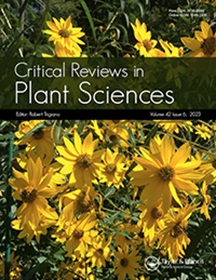Epigenetic Control of Carotenogenesis During Plant Development
IF 6
2区 生物学
Q1 PLANT SCIENCES
引用次数: 16
Abstract
Abstract Carotenoids are secondary metabolites synthesized in plastids that function in photosynthesis, photoprotection, growth and development of plants. Carotenoids contribute to the yellowish, orange and pinkish-red hues of leaves, flowers and fruits, as well as various aromas. They provide substrates for the biosynthesis of phytohormones and are cleavable into smaller apocarotenoids that function as retrograde signals and/or mediate intracellular communication as well as regulate gene transcription and/or protein translation. Carotenoid biosynthesis and gene regulation are tightly coordinated with tissue-specific plastid differentiation, seedling morphogenesis, fruit development, and prevailing environmental growth conditions such as light, temperature and mycorrhizal interactions. In the last decade, epigenetic processes have been linked to the regulation of carotenoid biosynthesis, accumulation and degradation during plant development. Next-generation sequencing approaches have shed new light on key rate-limiting steps in carotenoid pathways targeted by epigenetic modifications that synchronize carotenoid accumulation with plastid development and morphogenesis. We discuss how histone modifications (methylation and acetylation), DNA methylation and demethylation, as well as small RNA gene silencing processes can modulate carotenoid biosynthesis, accumulation and apocarotenoid generation throughout the plants’ life cycle: from seed germination to fruit morphogenesis. This review highlights how apocarotenoid signals regulate plastid biogenesis and gene expression in sync with chromatin alterations during skotomorphogenesis and photo-morphogenesis. We provide a new perspective based upon emerging evidence that supports a likely role for carotenoids in contributing to the programming and/or maintenance of the plants' epigenetic landscape.植物发育过程中胡萝卜素生成的表观遗传学控制
摘要类胡萝卜素是质体中合成的次生代谢产物,在植物光合作用、光保护、生长发育中发挥作用。类胡萝卜素有助于叶子、花朵和水果的黄色、橙色和粉红色,以及各种香气。它们为植物激素的生物合成提供底物,并可裂解成较小的类胡萝卜素,这些类胡萝卜素起逆行信号和/或介导细胞内通讯以及调节基因转录和/或蛋白质翻译的作用。类胡萝卜素的生物合成和基因调控与组织特异性质体分化、幼苗形态发生、果实发育以及主要的环境生长条件(如光照、温度和菌根相互作用)密切协调。在过去的十年里,表观遗传学过程与植物发育过程中类胡萝卜素生物合成、积累和降解的调节有关。下一代测序方法为表观遗传学修饰靶向的类胡萝卜素途径中的关键限速步骤提供了新的线索,这些修饰使类胡萝卜素积累与质体发育和形态发生同步。我们讨论了组蛋白修饰(甲基化和乙酰化)、DNA甲基化和去甲基化以及小RNA基因沉默过程如何在植物的整个生命周期中调节类胡萝卜素的生物合成、积累和类胡萝卜素生成:从种子发芽到果实形态发生。这篇综述强调了类胡萝卜素信号如何在精子形态发生和光形态发生过程中与染色质改变同步调节质体的生物发生和基因表达。我们基于新出现的证据提供了一个新的视角,这些证据支持类胡萝卜素在植物表观遗传景观的编程和/或维持中可能发挥的作用。
本文章由计算机程序翻译,如有差异,请以英文原文为准。
求助全文
约1分钟内获得全文
求助全文
来源期刊
CiteScore
12.90
自引率
1.40%
发文量
15
审稿时长
>12 weeks
期刊介绍:
Critical Reviews in Plant Sciences focuses on presenting in-depth and up-to-date reviews of timely and/or cutting-edge subjects in the broad discipline of plant science, ranging from molecular biology/biochemistry through the areas of cell biology, plant pathology and physiology, genetics, classical botany, and ecology, to practical agricultural applications. Articles in the journal provide an up-to-date literature base for researchers and students, pointing the way towards future research needs. The journal is also a significant source of credible, objective information to aid decision makers at all levels.

 求助内容:
求助内容: 应助结果提醒方式:
应助结果提醒方式:


